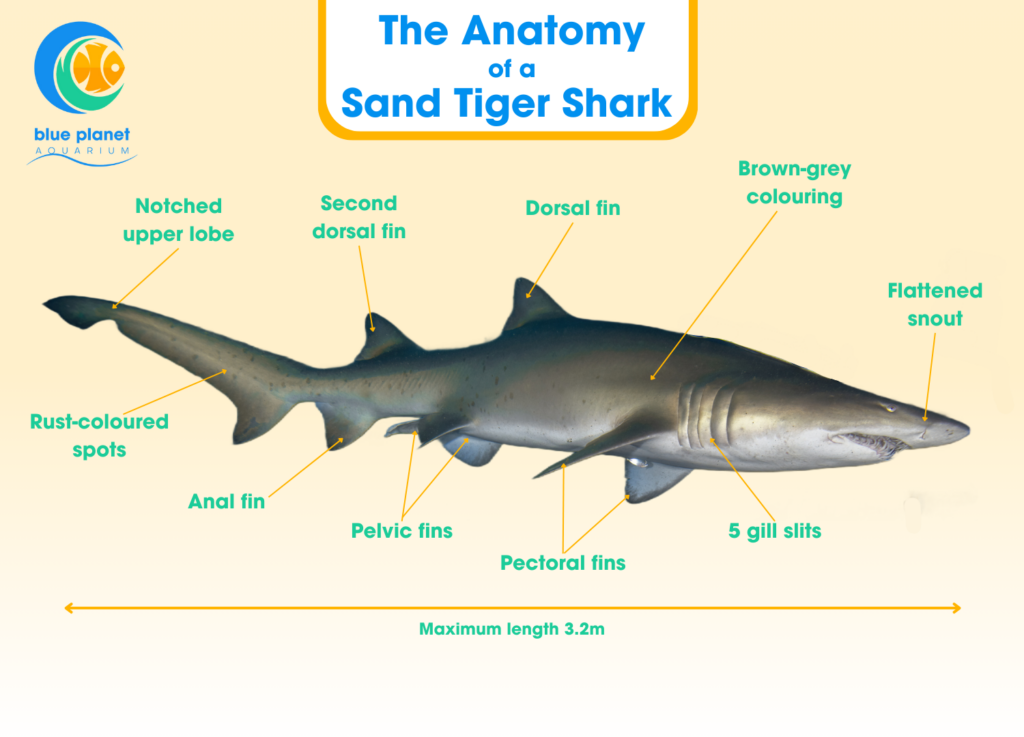Sharks really are magnificent creatures, and with so many different species, they are a fascinating group of aquatic animals that we should all try to learn more about. From the biggest sharks to the smallest, each have their own characteristics and features, and you can see a number of different species right here at Blue Planet Aquarium.
When it comes to a shark’s appearance, you might think you already know everything about what a shark looks like. So, let’s see if we can discover something new about the anatomy of a shark, in particular the impressive sand tiger shark.
Where can you see sand tiger sharks?
The sand tiger shark (Carcharias taurus) is called such because they are typically found along the sandy shorelines of warm and tropical seas. You’ll find sand tiger sharks in the Pacific, Indian and Atlantic Oceans.
However, if you fancy seeing these gentle giants with your very own eyes, you can find our very own sand tiger sharks right here, in our Ocean exhibit! With our 4 million litre marine display and underwater tunnel, you’ll be able to see sand tiger sharks and more swimming alongside you as you walk through the exhibit – giving you a chance to study their anatomy up close!
Here’s our handy visual to help you identify the different parts of a shark’s anatomy, so you can print it off or open it on your phone as you wander through the aquarium. See how many body parts you can spot!

What is a shark’s body like?
Sharks are typically known for having a fusiform body shape, which means it is rounded and tapered at each end. They are covered in scales, called denticles, which are like sandpaper to touch. These denticles point backwards which helps the shark to swim at a faster pace.
Sharks have a number of different fins, including the caudal fin often referred to as the tail. They also have a pelvic fin on their underside, pectoral fins to help with balance and steering, and the dorsal fin on the upper side to help the shark stay upright! Some sharks, like the sand tiger shark, have two dorsal fins to help even further.
Does a shark have a skeleton?
One of the most interesting characteristics of a shark is that it doesn’t have a traditional skeleton made up of bones. Instead, sharks are cartilaginous, which means their skeleton is made out of cartilage – the same material that our ears and noses are made from!
This is important because cartilage is more flexible and lighter, so the shark can move quickly through the water and stay buoyant. This also means that sharks don’t necessarily have a traditional spine of bone, but instead a vertebral column of spines that is also made out of cartilage.
Other cartilaginous fish include rays and skates.
How many teeth does a shark have?
Depending on the species of shark, they can have between 50-300 teeth at any one time. However, throughout their lifetime they may go through 30,000 teeth! This is because sharks constantly shed and regrow teeth.
Sharks can typically have 4 different types of teeth:
- Triangular serrated teeth: These are pointed with serrated edges, designed to act like a knife. Great white sharks and tiger sharks typically have teeth of this shape.
- Needle-like teeth: They are long and sharp, and can be either straight or curved to help the species catch its prey. Bull sharks, for example, have needle-like teeth that are serrated and are designed to act like a fork.
- Flat, strong teeth: These teeth are great for crushing their prey, so they can feed on hard-shelled creatures like crustaceans. Port Jackson sharks and nurse sharks have this kind of teeth.
- Non-functional teeth: Filter feeding sharks like the whale shark and basking shark feed by sucking water through their mouths and filtering with baleen, like whales, and while they do have teeth, the species have evolved to no longer need them.
The sand tiger shark has long, narrow cusps with small lateral cusplets, giving them the appearance of jagged teeth that protrude in all directions. These teeth are always on show, even when their mouths are closed!

How do I recognise a sand tiger shark?
A sand tiger is a fascinating species and have some distinct features to help you recognise them. Firstly, this species is typically brownish-grey with rust-coloured spots on top, and a white underside.
Their snout is flattened with a ski slope shape, and their distinctive caudal fin has a notched upper lobe. On average a sand tiger shark will be around 2.5 metres, although they have been known to grow up to 3.2m in length.
Fun facts about the sand tiger shark
If you’ve not already learned enough about the sand tiger shark, here are some more fascinating facts for you!
- Their name comes from their habitat and their big appetite, and are not actually related to tiger sharks. In Australia, they are known as the grey nurse shark, and in South Africa they are typically referred to as ragged tooth sharks.
- They are cousins of the great white shark, but aren’t considered a threat to humans.
- They are the only known shark to come up to the surface to gulp air. They do this to help them become more buoyant, so they can float motionless in the water waiting for prey.
- The sand tiger shark gives birth to live young, called pups, which can swim and eat straight away.
Sand tiger sharks really are quite interesting, with their unique appearance and curious habits. Don’t forget you can come and see them for yourself here at Blue Planet Aquarium – book your tickets today!
